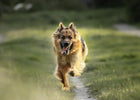
Regeneration in dogs: how the body recovers after exercise
, by Marc Kelchtermans, 7 min reading time

, by Marc Kelchtermans, 7 min reading time
Recovery is one of the most important, yet often underestimated, aspects of athletic performance. Proper recovery after training or intense exertion is crucial not only for professional sporting dogs, but also for hobby athletes or active pets. Understanding regeneration processes helps prevent overuse and muscle injuries and supports the long-term health of the musculoskeletal system.
Regeneration is an active, biological process in which the body not only repairs micro-injuries caused by movement but also builds new tissue, restores the function of muscles, tissues, and the nervous system, and replenishes energy reserves. Regeneration is not simply "rest," but an active, well-regulated biological and physiological process.
The regeneration starts almost immediately after the end of the activity, but can be divided into several phases:
Please note: if we do not provide sufficient regeneration time, micro-injuries will occur → this leads to overtraining and injuries.
It is important to know that regeneration is not completely linear and does not consist exclusively of muscle regeneration. For example:
The type and intensity of the training, as well as the dog's age, health, and fitness level, also play a role. After moderate activity or light training, one to two days may be sufficient, while with intensive, long, or competitive training, recovery can take several days.
The risk of reloading too often or too early is that microinjuries don't heal properly and accumulate. This can lead to injuries or overtraining in the long run.
For sporting dogs or particularly active pets, training days are usually planned so that at least one to two recovery days are included in the weekly training schedule. This doesn't necessarily mean complete rest; it can also mean light, active rest.
Active rest: Daily gentle walking and light exercise improve blood flow to the muscles and speed up the removal of waste products.
Massage and manual therapy: Techniques performed by a specially trained physiotherapist reduce muscle tension and promote lymphatic circulation.
Hot-cold therapy: After a recent intense workout, cold the inflammation; after 1–2 days it can heat promote blood circulation and relaxation.
Nutritional supplements:
Adequate sleep and rest: The most active regeneration phase occurs during sleep. A calm environment and minimizing stress are crucial here.
Adequate hydration: Dehydration slows down metabolism and hinders regeneration.
BCAAs (Branched-Chain Amino Acids) are three essential amino acids: leucine, isoleucine, and valine They are essential for muscle protein synthesis, or muscle building and regeneration, because the body cannot produce them itself and must therefore be ingested through food. Therefore, all three are naturally present in the active ingredients of Vitaltier Sport & Activity .
BCAAs are not only the building blocks of muscle but are also metabolized differently in muscle tissue, rather than in the liver, making them a direct energy source for muscles during intense exercise. This means BCAAs can directly meet muscle energy needs, especially when glycogen stores (the traditional energy source) are depleted.
In addition, the BCAA leucine particularly important because it acts as a "switch" to initiate muscle protein synthesis through a pathway called mTOR (mechanistic target of rapamycin), which is essential for muscle building and regeneration. This molecular signal stimulates cell growth and regeneration, making leucine essential for muscle tissue repair.
In dogs, it is particularly interesting that BCAAs help prevent muscle loss, for example in older animals or animals recovering from illness. This is important because dogs' muscle mass can rapidly decline due to aging or prolonged immobility, which can reduce mobility and quality of life. Supplementing with BCAAs can help maintain muscle mass and accelerate regeneration in such cases.
In addition, BCAAs reduce muscle damage after physical exertion, meaning less pain and faster recovery. This is especially beneficial for sporting and working dogs.
Reloading too early: If the dog has not fully recovered from the previous training, further training will only increase the chance of micro-injuries.
Too little rest time: The "every day is necessary" principle doesn't always apply to sporting dogs. One to two active regeneration days per week are key.
Insufficient nutrition: If the body does not get enough nutrients, it has no ability to build muscle tissue.
Chronic stress: High levels of cortisol (the stress hormone) reduce recovery capacity, inhibit muscle building and increase inflammation.
Hidden pain or injury: If a dog is constantly "compensating" because it is in pain somewhere, the entire movement pattern is disrupted and regeneration cannot take place properly.
In case of such complaints it is certainly worthwhile to consult a physiotherapist.
An experienced physiotherapist:
Regeneration isn't passive rest, but a consciously supported process that's key to a dog's long-term musculoskeletal health and athletic performance. With proper attention, gentle transitions, and targeted physical therapy, the risk of injury can be significantly reduced and the dog's energetic, happy movement can be maintained.
source: Vitaltier.hu